|
BOTTICELLI - THE BIRTH OF VENUS
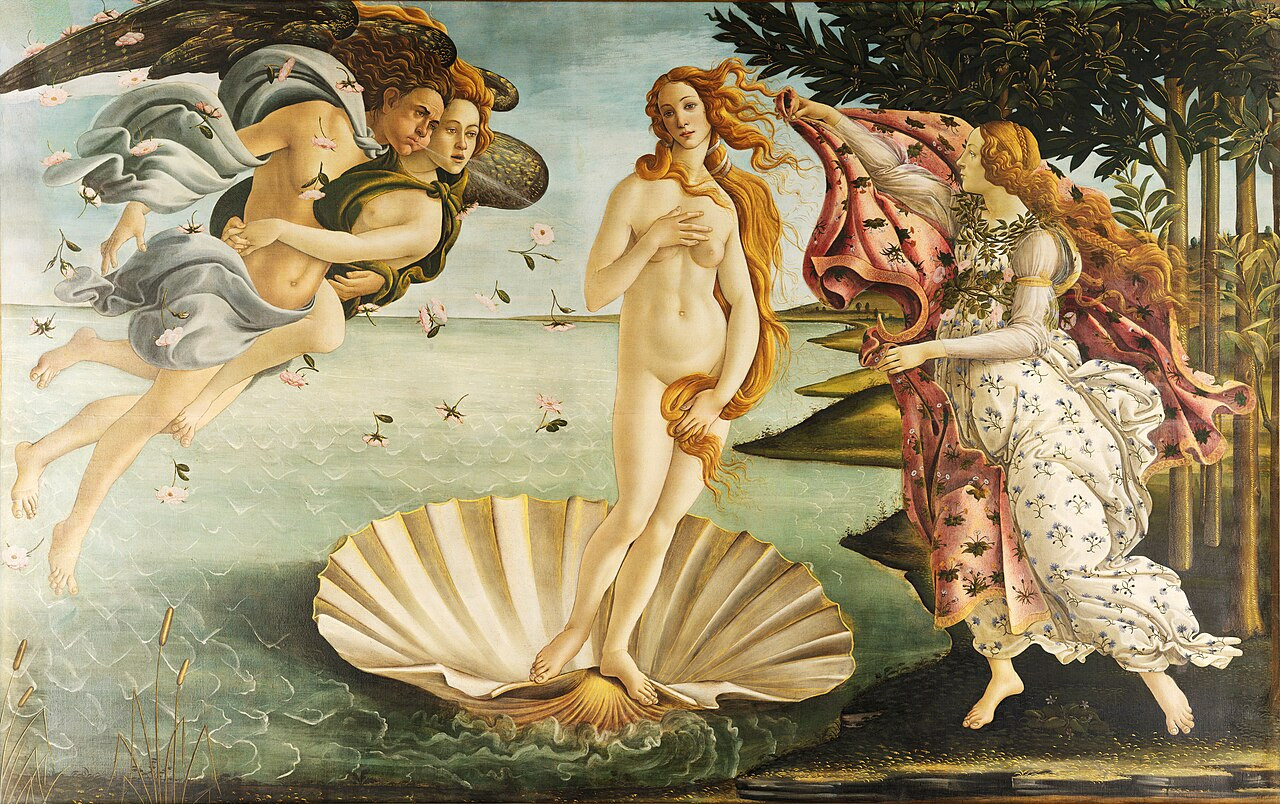
Sandro Botticelli, Public domain, via Wikimedia Commons
1485
|
- Botticelli's most famous work,
The Birth of Venus, depicts his supposed first love, Simonetta Cattaneo de Vespucci
as his model.
- The painting was not named by Botticelli although the
subject was always about Venus, the official name wasn't derived until the
19th-century.
- Many believe that the imagery was inspired by the poem
Stanze per la Giostra written in 1475–8 by Angelo Poliziano, who also worked in the Medici court in Florence.
- Venus
in Roman and Aprhodite in Greek is the central theme.
|
Then the son from his ambush stretched forth his left hand and in his right took the great long sickle with jagged teeth, and swiftly lopped off his own father’s members and cast them away to fall behind him. And not vainly did they fall from his hand; for all the bloody drops … were swept away over the main a long time: and a white foam spread around them from the immortal flesh, and in it there grew a maiden … Her gods and men call Aphrodite, and the foam-born goddess and rich-crowned Cytherea.
(Hesiod, Theogony)
|
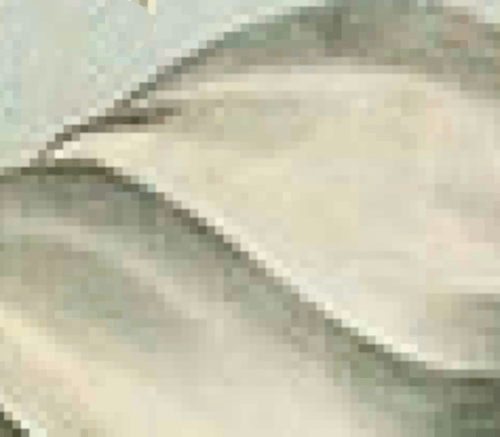
Blank canvas |
- It was also unusual for the time because it was
tempera painted on two pieces of canvas sewn together and
treated with blue gesso, instead of painted on wood.
- Canvas worked well in humid regions where wood panels
tended to warp although it was considered less formal.
-
Commissioned by a member of the Medici's and as a
novelty, it was most likely painted for a country home as a
wedding gift to a newlywed couple from the Medici family.
-
The painting resides in the Uffizi Gallery in Florence, Italy.
|
While there are subtleties in the painting, its main
meaning is a straightforward, if individual, treatment
of a traditional scene from Greek mythology, and its
appeal is sensory and very accessible, hence its
enormous popularity.
(Wikipedia)
|
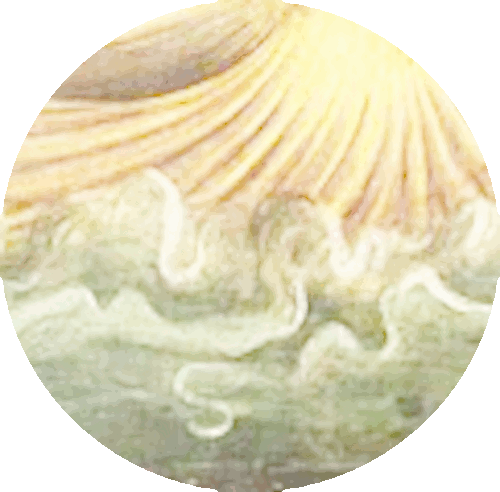
Morning star |
- The Bible frequently refers to Venus as the Morning Star (or Evening Star, depending on its position in the sky).
- This name comes from its bright, shining appearance as it rises before the sun in the morning or sets after sunset.
|
I, Jesus, have sent my angel to give you this testimony for the churches. I am the Root and the Offspring of David, and the bright Morning Star.
(Revelation 22:16)
|

Rebirth |
- The Renaissance, a period marked by a rebirth of learning, art, and culture, originated in Italy during the 14th-century and spread across Europe.
- This era witnessed an unparalleled flourishing of the arts, supported largely by wealthy patrons like the Medici family in Florence.
- The Medici's influence in the Renaissance was profound,
shaping the cultural landscape of the time and encouraging the
revival of classical themes and styles in art.
|
Sing in me, Muse, and through me tell the story
of that man skilled in all ways of contending,
the wanderer, harried for years on end,
after he plundered the stronghold
on the proud height of Troy.
(Homer, Odyssey)
|
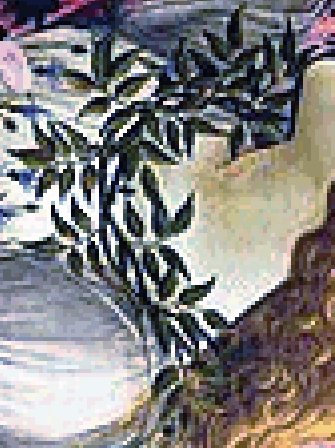
Neoplatonic
laurel wreath |
- Botticelli didn't just paint graceful figures, he encoded
Neoplatonic ideas about beauty as a reflection of the divine.
- The church may have ruled the surface, but beneath the
brushstrokes, Renassance artists like Botticelli and DaVinci
were part of a quiet revolution.
- A revolution that
blended faith with philosophy combined with hidden knowledge
into timeless masterpieces.
- The work is based on the
Neoplatonic concept of love as life-giving energy as the
driving force of nature.
|
Botticelli was renowned for crafting remarkable hairstyles. In his Birth of Venus (ca. 1485), the goddess of love sports a spirited mane, splitting into undulating locks like jellyfish tentacles. (Emanuele Lugli)
|
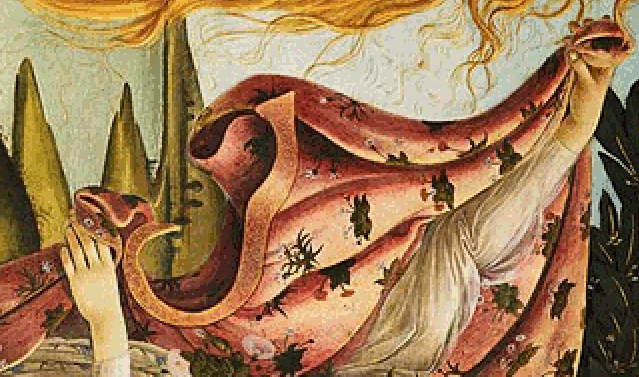
Lush garden |
- For example, Botticelli's Primavera appears as
a lush garden with elegant figures draped in flowing
robes, but look closer and you'll notice something unusual.
- Every element, from the positioning of the figures to the
flowers under their feet.
- It's not just a scene about
seasonal beauty, it carries an allegory, it's a carefully
constructed allegory, steeped in the esoteric philosophies
that interested Botticelli and his patrons.
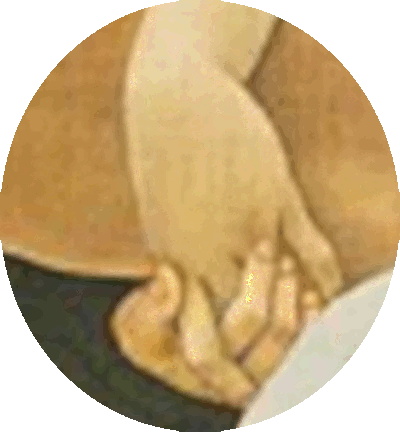
Intertwined hands |
- This was the divine harmony, love, wisdom and truth
reflecting the celestial order of the comets.
- Even their
intertwined hands mimic the interconnectedness of all things,
a core belief in Hermetic thought.
- Here, Botticelli mixes
pagan with Christian symbolism.
- Venus as both goddess and
a representation of modesty and chastity, embodying the
Neoplatonic idea of love as a cosmic force.
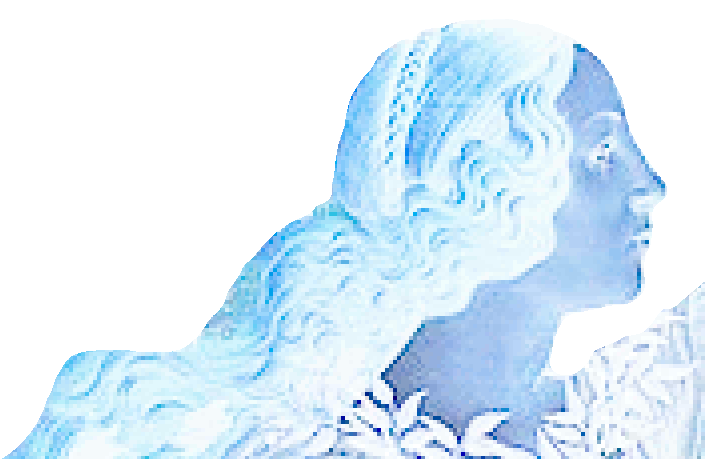
Queen of Heaven |
- Romans knew her as the goddess Venus, while for the Greeks she was Aphrodite.
- Aphrodite derives from a predecessor: the Ancient Mesopotamian warrior goddess Ishtar, known as the Queen of Heaven.
|
The planet Venus and Jesus are linked in Christian theology due to Venus being referred to as the "Morning Star" in the Bible, a title also given to Jesus in Revelation 22:16. This connection suggests a symbolic parallel between the planet's bright appearance and Jesus's radiant glory and hope.
(Assistant)
|
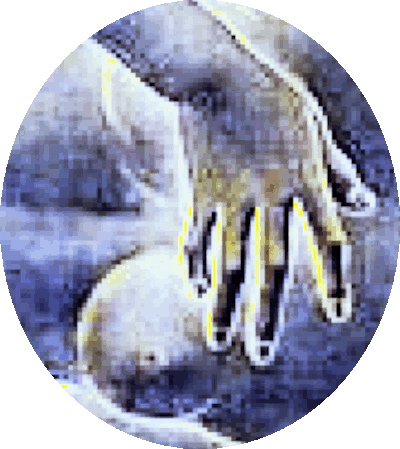
Neoplatonic One |
- This is an example of Botticelli's use of
Neoplatonic philosophy, where Venus represents the ideal of divine beauty and love, a drive for life and spiritual enlightenment.
-
Neoplatonism, which was discussed and written about in Lorenzo De Medici’s circle was based on the idea of the spiritual and the divine combining with the earthly and the physical.
- These were two radical opposites with the divine balancing the earthly desires
and needs.
|
She stands tall and naked at the centre of the canvas, looking ethereal and luminous. She seems to draw all attention to herself; a symbol of beauty, who is both physical and spiritual. If you believe the neoplatonic philosophers, contemplating her beauty is a way to elevate the human spirit and get closer to the divine.
(lovefromtuscany.com)
|
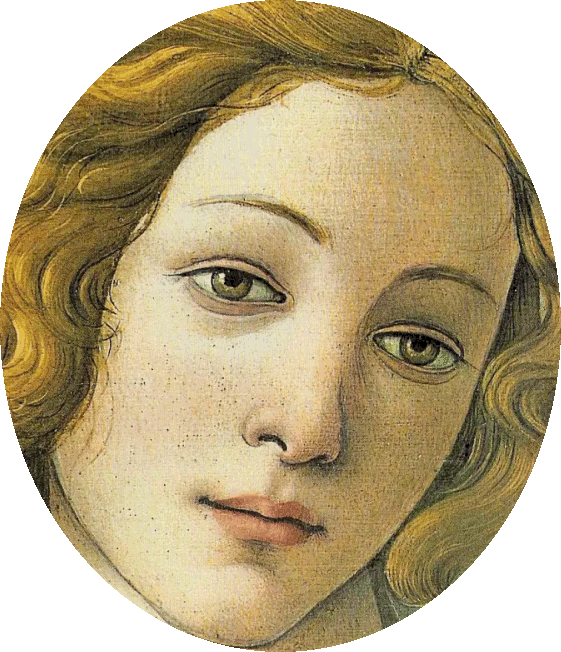
Physical beauty with humility |
-
These became the ideal of female beauty during the Renaissance; the combination of physical beauty with humility, purity with desire, delicacy with strength.
- The goddess Venus entwined these opposites of sensual with the pure.
|
The balance of Venus is also presented through the colours that add sereneness. Her posture almost defies gravity. The entire scene is constituted to be fantastical – otherworldly, beyond the grasp of human elements and almost evanescent. This is to say that beauty is not restricted to earthly needs.
(bibliophiliaforever.wordpress.com)
|
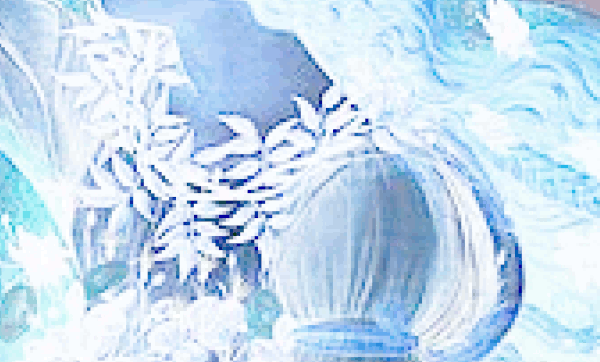
Classical culture |
- Botticelli depicted the leaning figure of Venus in his painting as Ecclesia (the Church).
- The painting embodies the humanist ideals of the Renaissance, which emphasized human potential and the value of classical culture.
- To those initiated in the
pagan rites, her pose mirrors statues of Aphrodite from
antiquity, but Botticelli layers Christian and esoteric
meaning into her form.
- This was more than artistry, it was visual instruction for
those initiated into the hidden philosophies of the age.
|
Venus, anxious for her son’s affairs, New counsels tries, and new designs prepares.
(Virgil, The Aeneid)
|
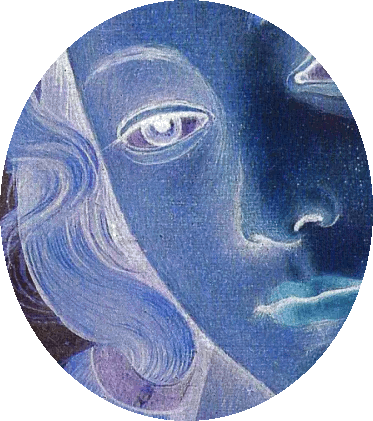
Ripple of water |
- The painting holds a mesmorizing secret, it isn't just
about the goddess emerging from the sea, this iconic
painting is a visual hymn to ancient mystery traditions.
- A coded masterpiece where every ripple of water, and every
falling flower carries weight.
- Venus stands on her
shell not merely as a figure of beauty, but as a symbol of
Neoplatonic 'divine emanation.'
- This is the belief that
all creation flows from a single, sacred source.
|
The painting's serene beauty, harmonious palette, and ethereal atmosphere have inspired countless artists and admirers over the centuries.
(Assistant)
|
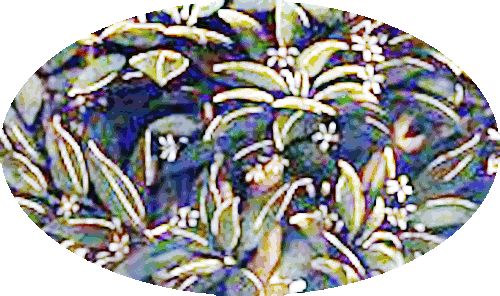
Blossoms |
- The flowers in the painting symbolize birth and spring, and include roses, orange blossoms, daisies,
blue cornflowers, and yellow primroses.
-
Roses are falling from the sky and are associated with Venus' birth according to legend
because out of the foam came white roses.
- The nymph on the right is also depicted with a dress
embroidered with daisies, cornflowers, and primroses, all
spring flowers signifying birth.
|
This impressive mythological composition is centered on the introduction of the figure of the bare naked goddess Venus emerging from the shell drifting to Cyprus shore. (Balasz Takac)
|

Fallen angel |
- A ‘fallen angel’ motif representing Leonardo can be
found in the painting and was a reference that ties to
Botticelli's Venus and Mars painting where the three small
figures are teasing and taunting Mars, known as Leonardo DaVinci, the damned man.
- The piece was controversial because it was the first secular painting to depict nudity.
|
“Like a bolt of lightening from heaven” (Luke 10:18), or perhaps from his failed attempt at flying that seemed like a bird falling out of the sky. A ‘fallen angel’ motif representing Leonardo can be found in another Botticelli painting, The Birth of Venus, and also as a winged Medusa-type face on the breastplate of the terracotta bust by Andrea del Verrocchio depicting Giuliano de’ Medici. (Catchlight)
|
|
Venus is Aphrodite |
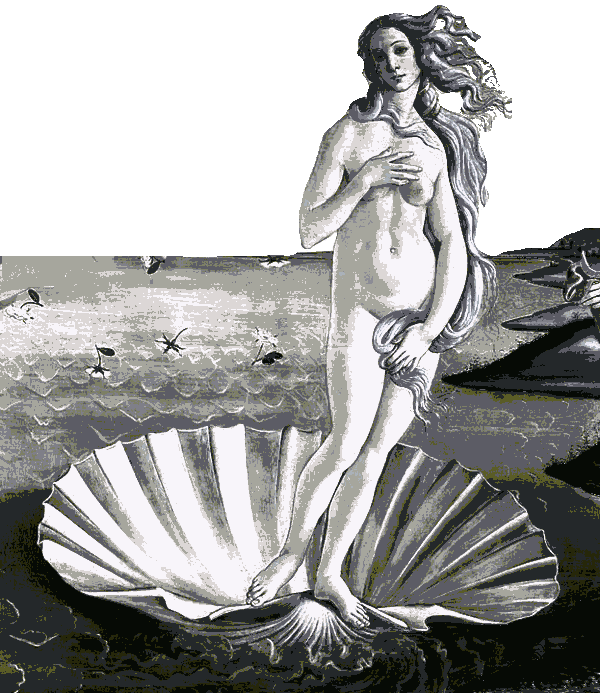
Newly-born goddess |
- The focal point of this painting is the figure of a newly-born goddess
standing in a giant scallop shell that emerged from the sea.
- The theme of the
Birth of Venus was taken from the writings of the ancient poet, Homer.
- According to the traditional account, after Venus was born, she rode on a seashell and sea foam to the island of Cythera.
- In the painting we see here, Venus, who has coppery
blonde hair, is prominently depicted in the center, born out of the foam
who landed on a grassy beach.
- Notice that the landscape is rather dark and Venus, the
'Gothic ivory' creates the light.
|
Give me my scallop shell of quiet;
My staff of faith to walk upon;
My scrip of joy, immortal diet;
My bottle of salvation;
My gown of glory (hope's true gage)
And then I'll take my pilgrimage.
(Sir Walter Raleigh)
|
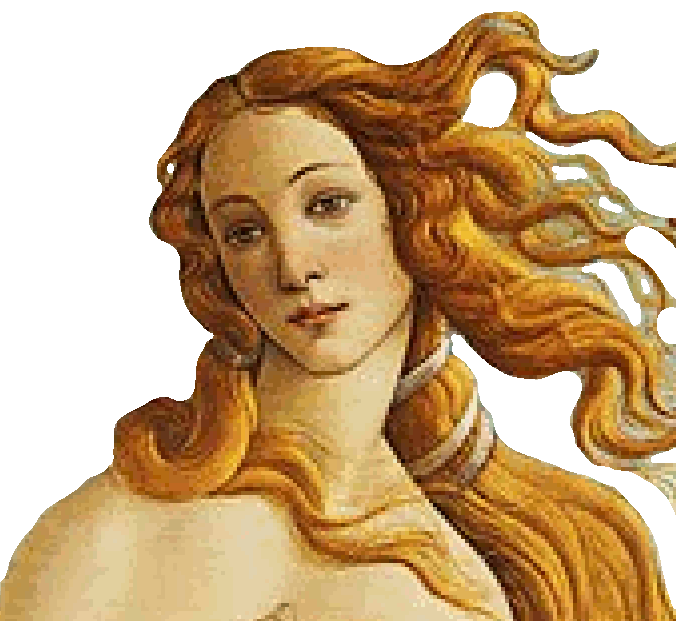
Simply beautiful |
- Botticelli paid much attention to her hair and hairstyle, which reflected his interest in the
style women wore their long hair in the late
15th-century.
- The way her hair cascades like liquid gold
isn't just artistic flair, it echoes descriptions of the
goddess in ancient Orphic Hymns where her radiance was said to
illuminate hidden wisdom.
- Venus has an idealized face which is simply
beautiful and remarkably free of blemishes.
- Her face is shaded
to distinguish the shadow of the sun and Botticelli used gold
leaf
to add highlights to her hair.
- The sash in her hair has
the symbolic value of binding together and uniting, alluding
to a bond.
- In Botticelli's
Primavera we see another side of Venus as she is no
longer virginal, but pregnant with spring.
|
The Orphic Hymns are a collection of eighty-seven ancient Greek hymns addressed to various deities, which were attributed in antiquity to the mythical poet Orpheus. They were composed in Asia Minor (located in modern-day Turkey), most likely around the 2nd or 3rd centuries AD, and were used in the rites of a religious community which existed in the region.
(Wikipedia)
|
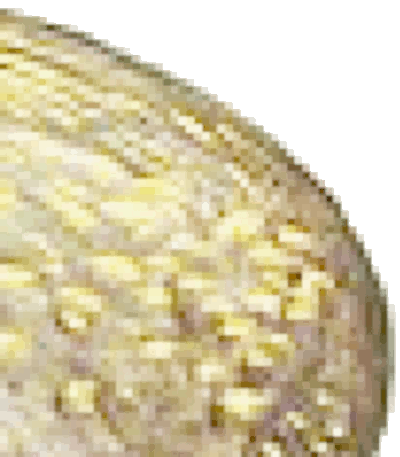
Touched by gold |
- You can see faint lines of gold used in other
sections of the painting including the highlights of the wings, or the stems and leaves of the roses,
and the tree trunks.
- Unfortunately, you can only see the
gold when viewing the actual painting.
|
Back in Medieval times, gold leaf was used to give an otherwordly quality to the art. You also have to take into account the fact that it was seen in dim churches, lit by candles. The ability of a painting to reflect light was rather important.
(baffledtimetravel.com)
|
|
Zepherus and Chloris/Flora |
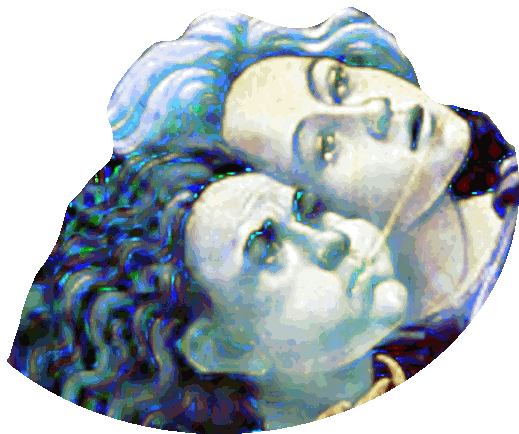
Zepher and nymph |
- On the left is the winged wind god Zephyr (Zephyrus) and his female peer
who are blowing the wind to guide Venus to shore symbolizing the breath of life and the gentle force of love.
- She called out to Zephyrus, husband and keeper of the west wind, asking him to blow away the clouds in the sky so that Apollo might allow the sun to cast down its warming rays.
|
Originating from Greek Zephyros and Latin Zephyrus, Zephyr means the mild, gentle west wind, linked to the dark west region in ancient mythology.
(Online Etymology Dictionary)
|
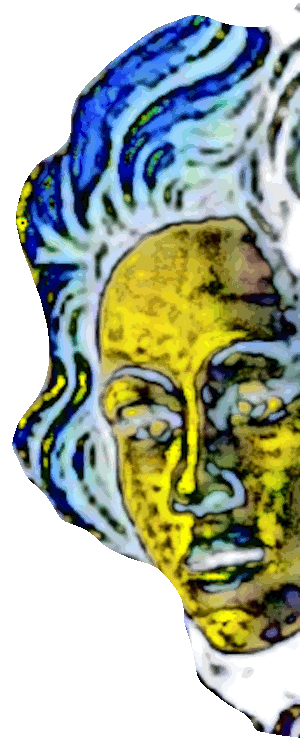
Aura |
- Art historian Giorgio Vasari claimed that this figure represents Aura, a personification of a
'lighter breeze' blowing at her.
- Aura who clasped
Zephyrus close to herself on one side in one of the hours.
- She was a virgin-huntress who was excessively proud of her
maidenhood and she had motions as swift as the wind.
-
Aura lived in the woods and dedicated herself solely to
fighting wild boars and lions averse to carnal love and
seduction.
- She never had any contact with Zephyrus but
suffered violence from Dionysus.
- Which makes it more
probable that it was not Aura, but Chloris, welcoming the
goddess Venus, an analogy with the flowers in the spring.
|
You would call the foam real, the sea real, real
the conch shell and real the blowing wind; you
would see the lightning in the goddess's eyes,
the sky and the elements laughing about her; the
Hours treading the beach in white garments, the
breeze curling their loosened and flowing hair;
their faces not one, not different, as befits sisters. (Poliziano's la Giostra, Stanza 100)
|

Watery west wind |
- The wind gods blowing
Venus toward shore, aren't just decorative.
- They
represent spiritual winds of change, the invisible forces
guiding the soul toward enlightenment.
- Zepharus was famed for bringing warm, moist air to the Mediterranean in spring, thus bringing the first crops on after the winter.
|
But, like a stormy day, now wind, now rain,
Sighs dry her cheeks, tears make them wet again.
(Shakespeare, Venus and Adonis)
|
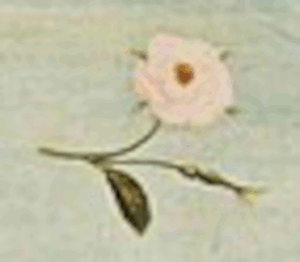
Chloris flowers |
- Aura has also
been identified as the nymph Chloris, who was known to the
Romans as Flora, associated with flowers, spring, and new growth, also known as the goddess of flowers.
- Chloris, representing the physical act of love, is in the
arms of Zephyrus, the west wind, who has captured her.
|
I know a bank whereon the wild thyme blows,
Where oxlips and the nodding violet grows.
(Shakespeare, A Midsummer Night’s Dream)
|

Wedding |
- After Zephyrus succeeds in taking her for his own, they are married and Chloris transforms into Flora, the Spring goddess.
- Here, Flora is depicted throwing flowers that have
been gathered in her dress which symbolizes both springtime and fertility
and they are floating down to Venus.
- Botticelli also depicted Chloris/Flora blossoming in
Primavera.
|
Horae |
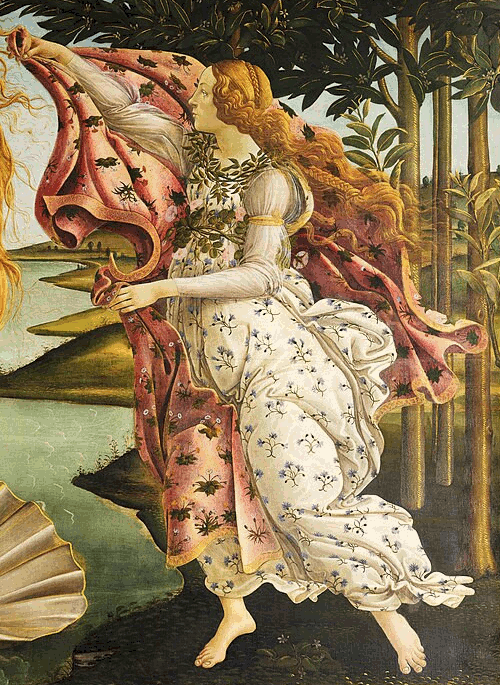
Hora of spring |
- On the right there is a female figure holding out a lavish cloak or dress to cover
the nude Venus when she reaches the shore.
- She is offering Venus a cloak
of dignity adorned with flowers, symbolizing the arrival of spring and new life.
-
This is the embodiment of one of the three Horae or Hours, minor Greek goddesses of the seasons
and the floral decoration of her gown suggests she is the Hora of Spring.
- The 'hours' were three sisters who symbolized the regular
flow of time and the alternating events of the seasons.
|
The Horae (plural), or Hora in the singular, were the Greek goddesses of the seasons and the natural order. They were also associated with order, justice, and peace, and were daughters of Zeus and Themis. Often depicted as blooming maidens, they were connected to the cycle of the year and the bountiful gifts of nature.
(Assistant)
|
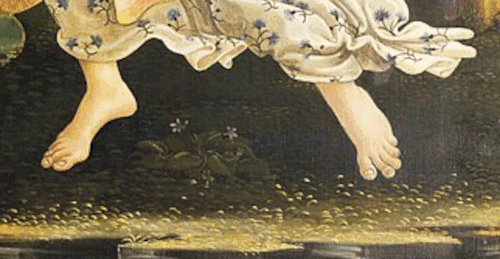
Hora floating |
- Hora may be floating above the ground.
- The robe she extends isn't just clothing, it's a shroud, a
veil of initiation.
- In mystery traditions, covering and
revealing symbolize the cycles of concealment and revelation.
- The idea that truth must be earned through spiritual
pursuit.
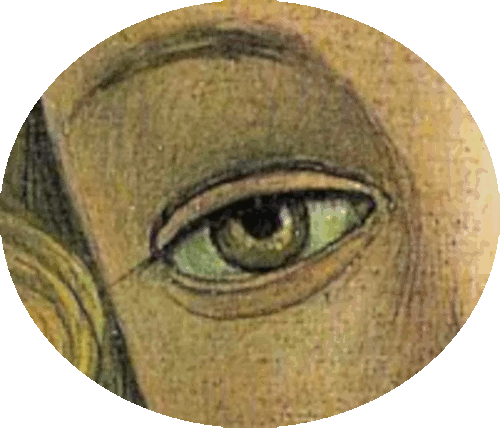
Looking deeper |
- Botticelli didn't paint this as a scene for passive
admiration, he painted a roadmap, a fusion of pagan devotion
and Renaissance esotericism.
- A scene where every detail
hinted at rituals long forgotten by the masses, but kept alive
by those who dared to look deeper.
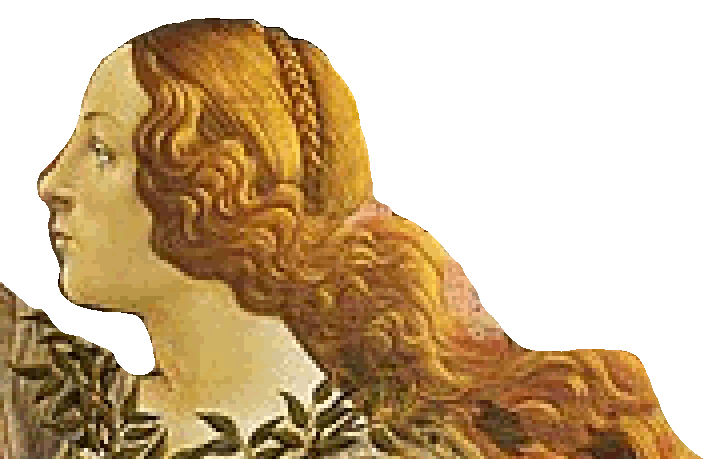
Thallo |
- Beyond the seasons, the Horae also embodied concepts of order, justice, and peace in both nature and human society.
- While sometimes depicted as a group of three, their specific names and roles varied, but often included Thallo (Spring), Auxo (Summer), and Carpo (Autumn/Harvest).
- Thallo was later called Flora by the Romans.
- They were frequently portrayed as beautiful young women
carrying the fruits and flowers associated with the seasons
they represented and were known to guard the gates of Mount
Olympus.
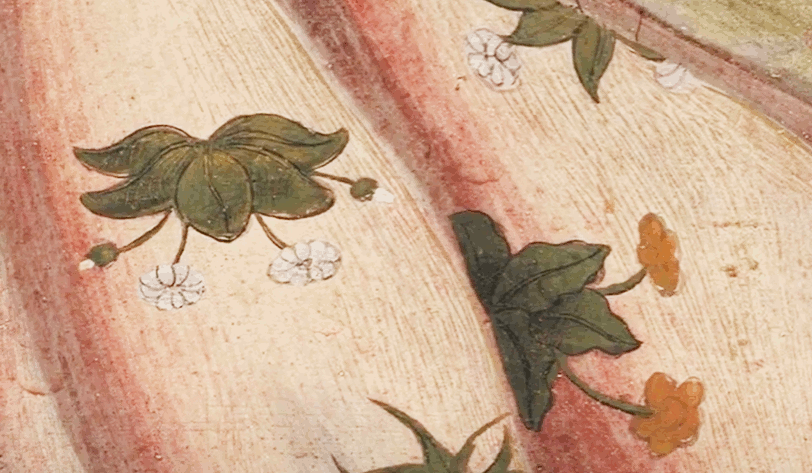
Buttercup |
- The Horae ruled over time and were Venus' attendants.
- Her mantle is embroidered with icons of daisies,
primroses and buttercups.
- Daisies symbolize youthful
innocence, free from guilt, sin and corruption as well as
matched feeling.
- They're also a hymn to conjugal love
through the voice of daisies and a symbol of requited
feeling
- The primrose is a symbol of youth and
the buttercup represents beauty and is associated with a
somewhat melancholy charm.
|
Throughout the centuries the scholars led comparative analyzes of Botticelli’s Venus and Primavera in order to determine the influence of ancient painters and the context of wedding festivities, as well as the influence of Renaissance Neo-Platonism.
(Balasz Takac)
|
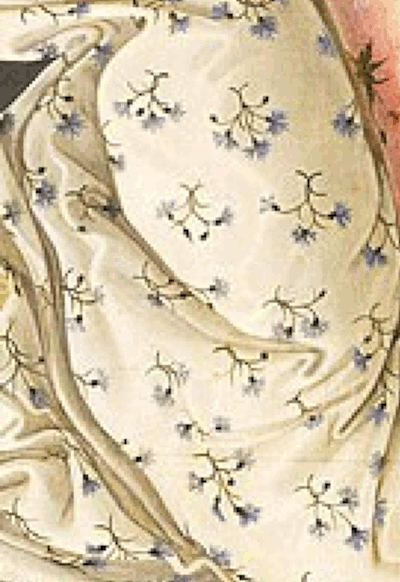
Florence textiles |
- Flora's white robe is richly decorated with garlands of
roses and blue cornflowers.
- This is the lily emblem of
Florence and the very name of the ancient Tuscan city,
Florentia, is derived from Flora representing its continuous
capacity for regeneration, in short, its eternity.
- The flowers in the air around Zephyr and on the textiles worn and carried by the Hora evoke the name of Florence
where the Medici's resided.
- As early as 1300, Florence was an important center of wool production and during the
14th-century the local industry invested in the development of silk manufacture, which soon became a crucial part of the Florentine economy.
|
As these highly decorative fabrics became increasingly fashionable, the Tuscan producers started to imitate the Oriental style in their own, local production. A curious example of these influences is the fortune of the motif of fenghuang, a fantastic bird from Mongolic tradition, which in the West was very quickly identified with phoenix.
(guidemeflorence.com)
|
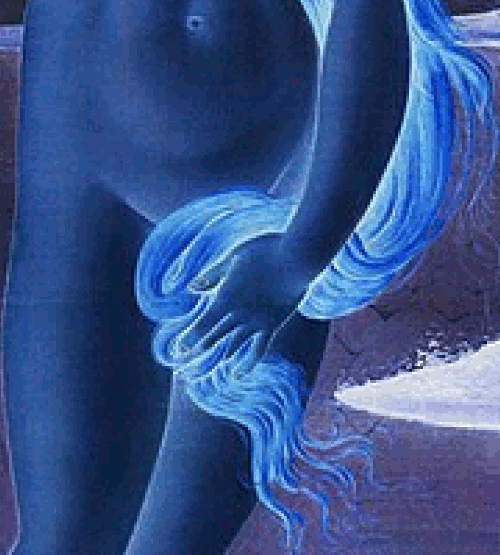
Flag lady |
- Simonetta Cattaneo de Vespucci who was the role model
for Venus was nicknamed la bella Simonetta ('the fair Simonetta').
- She was an Italian noblewoman from Genoa, the wife of Marco Vespucci of Florence and the cousin-in-law of Amerigo Vespucci
who America was named after.
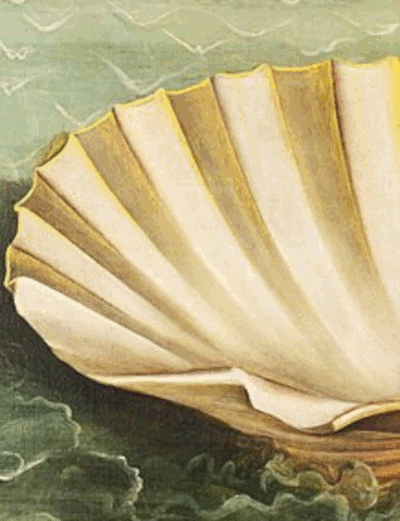
Scallop |
- The scallop shell represents
fertility rituals and honors femininity and has significant spiritual meaning, often symbolizing pilgrimage, transformation, and rebirth.
-
In Roman times the scallop shell was often a symbol for the genitals of a woman.
- It is not only the shell, the mollusk, the oyster and
its pearl, but also the female sexuality and in Christianity
means rebirth, resurrection and spiritual purification.
-
Notice that many churches have baptismal fonts shaped or
adorned like a conch shell.
- It's a powerful emblem associated with the Camino de Santiago, representing the pilgrim's journey, guidance, and interconnectedness.
|
The Camino de Santiago, also known as the Way of St. James, is a network of pilgrimage routes leading to the shrine of the apostle Saint James in the Cathedral of Santiago de Compostela in northwestern Spain. It's a journey steeped in history and spirituality, with routes spanning across Europe.
(Assistant)
|
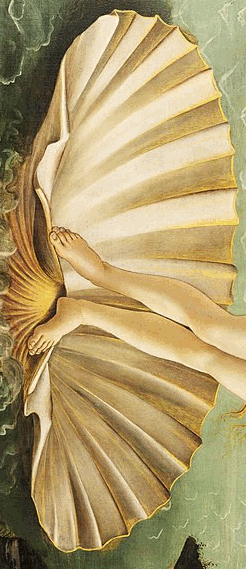
Cosmic womb |
- The shell is also a recurring symbol in alchemy and
Hermetism.
- Far from a simple seashell, it mirrors the
cosmic womb, the Vesica Piscus, a sacred geometric shape
representing the intersection of heaven and earth.
|
He that hath ears to hear, let him hear.
(Matthew 11:15)
|

Life force |
- The scene takes place where the four elements of
matter as understood by the ancients are found; water (sea),
air (breath of Zephyrus), earth (on which Flora stands) and
fire which is represented metaphorically by Venus' flaming
hair.
- Not only representing love and beauty, the
elements emphasize the balanced order that brings harmony to
the world.
|
This is the hot fire of passion which creates the propitious ground for decisions inspired by the living life giving breath which meets the moist soil begetting life.
(Ars Europa Channel)
|
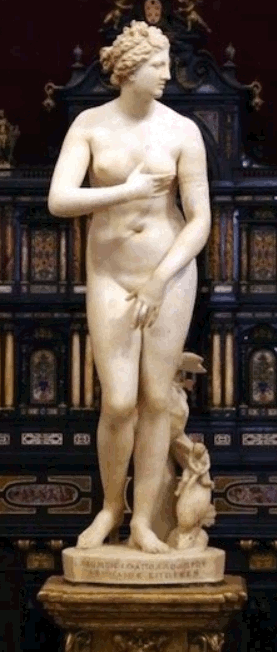
Venus Pudica |
- The inspiration for the painting is believed to be
from the Roman statue, Venus Pudica, Modest
Venus.
- Some have
compared the pose to ancient Roman sex workers but at some
point the message changed from outwardly provocative to
protecting and shielding.
- It is precisely this focus on modesty which appears to have made the
Venus Pudica a useful pose in Christian imagery.
|
Art historian George L. Hersey calls the Venus Pudica pose “perhaps the most celebrated bodily stance for female self-presentation in Western art.” He notes the implication that goddess has been noticed by the viewer and how she attempts to cover herself yet is “hardly panicked,” shaping her as “paradoxically both chaste and inviting.
(Sam Lirette)
|
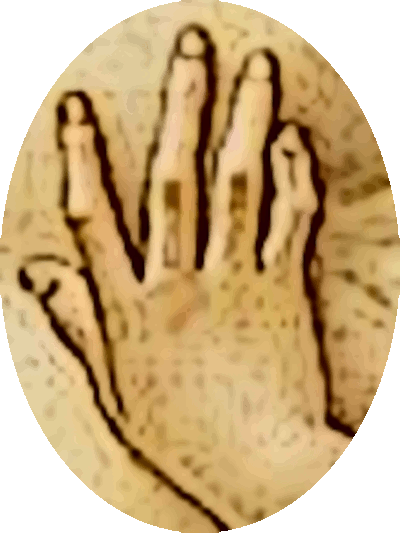
Classical subject matter |
- Her figure was modeled after an Aphrodite statue, such as the
Aphrodite of Knidos also known as Venus Pudica, in which the goddess attempts to cover herself in a gesture of modestly.
- The classical subject matter was something that would have intrigued wealthy Florentines who patronized this type of work.
- It would not have appealed to everyone, however, like the
working class who viewed the worldly behavior of the ruling
Medici family as corrupt or vile.
|
The Aphrodite of Knidos (Cnidos) was a marble carving of the goddess Aphrodite by the sculptor Praxiteles, which was bought by the people of Knidos in the middle of the 4th century BC. It depicted the goddess Aphrodite as she prepared for the ritual bath that restored her purity, discarding her drapery with one hand, while modestly shielding herself with the other.
(Assistant)
|
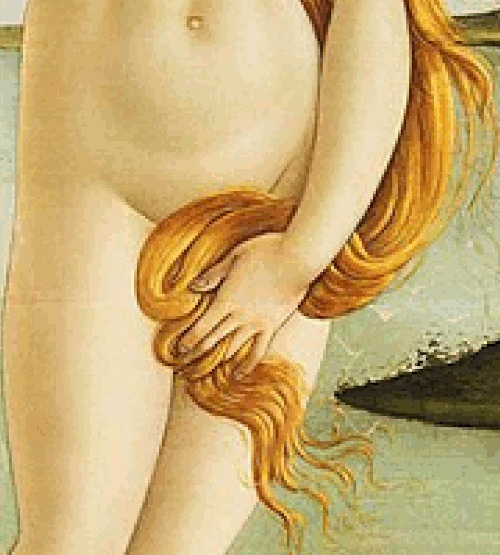
Shame and guilt |
- It was the first secular painting to incorporate nudity.
- Prior to Botticelli's painting, nudity was only used in religious art to depict the sin of Eve.
-
The act of concealing and revealing, veiling and exposing was
apparently of great importance in the Christian church and
tied to the emphasis on shame and guilt they promoted.
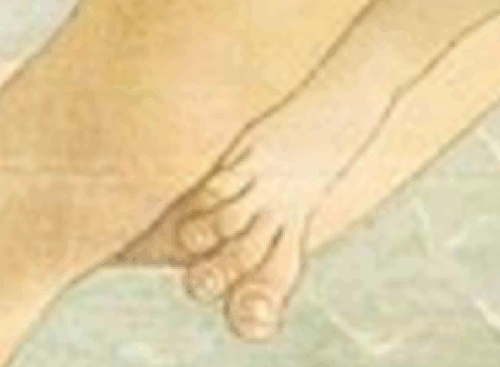
X-rated Adam |
-
Some have found it fascinating that while Adam only covers his
face in artwork, Eve assumes the more modest pose which certainly there
was a clear connection between female sexuality and shame.
- Venus, however, does seem to be more modest and not in
shame, seen in her rather blank expression and she exhibits a certain ambivalence.
|
By the 1490s, the tension that resulted from the clash between courtly excess and those who wanted religious reform came to a climax when the preacher Savonarola preached his crusade to the people of Florence. One of the people influenced by the preacher was Botticelli, whose change of heart moved him to destroy some of his early painting by fire.
(italianrenaissance.org)
|

Paradox and enigma |
- Venus is somewhat of a paradox because she is not as
openly shamed into modesty as the Christian role model.
-
As described in thee Homeric Hymns which revealed her dual nature; she inhabits a position between mortal and deity, and between modesty and immodesty.
|
Muse, sing the deeds of golden Aphrodite,
Who wakens with her smile the lulled delight
Of sweet desire, taming the eternal kings
Of Heaven, and men, and all the living things
That fleet along the air, or whom the sea,
Or earth, with her maternal ministry,
Nourish innumerable, thy delight
All seek ...
O crowned Aphrodite!
(Percy Bysshe Shelley, Homer's Hymn to Venus)
|
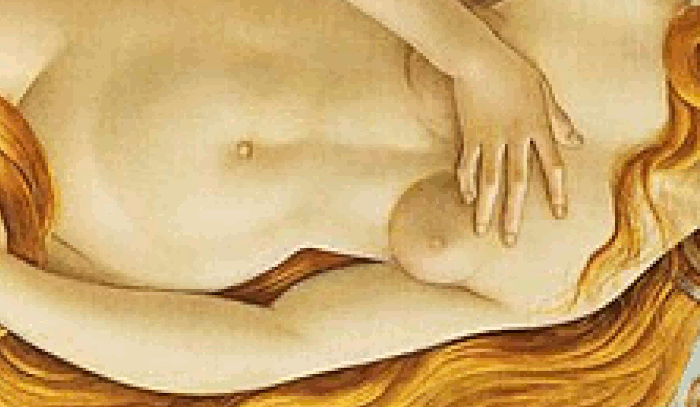
Study of anatomy |
-
The study of anatomy was performed in secret and frowned upon by the church.
- Certainly some artists saw babies, some artists saw naked people
and some artists saw naked women although the open study of such was still a radical idea.
- Because of this, artists like Leonardo studied anatomy at night and his books were kept secret.
|
Botticelli’s Venus was drawn, not from life, but from internalized models, and an idea of ideal beauty.
(Doug Rogers)
|

Sea water |
- The sea is a symbol of birth and transformation, representing Venus' origin and the beginning of her existence.
- In essence, The Birth of Venus is a celebration of beauty, love, and the rebirth of classical ideals in the Renaissance period.
- Venus, according to the Greek poet Hesiod who wrote the Theogony, was born out of sea foam.
- According to the Greek lyric poet Anacreon, the white rose first sprang forth during the birth of Aphrodite.
|
For Plato – and so for the members of the Florentine Platonic Academy – Venus had two aspects: she was an earthly goddess who aroused humans to physical love or she was a heavenly goddess who inspired intellectual love in them. Plato further argued that contemplation of physical beauty allowed the mind to better understand spiritual beauty.
(Wikipedia)
|
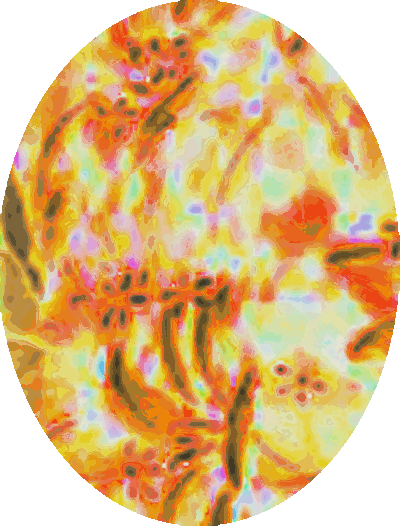
Blood red rose |
- A second rose-scented tale of Aphrodite involves her lover, Adonis, and the myth of how the rose turned red.
- One day, Adonis was out hunting boar. Ares, jealous of Adonis, had secretly sent the wild boar to harm him.
- At the last moment, Ares shares this knowledge with Aphrodite, who rushes to warn him.
- As she hurries to her lover’s aid, she scratches herself on a rose bush, splashing speckles of blood on their soft white petals, turning the blossoms red.
|
Rose-cheek'd Adonis tried him to the chase; Hunting he lov'd, but love he laugh'd to scorn; Sick-thoughted Venus makes amain unto him, And like a bold-fac'd suitor 'gins to woo him.
(Shakespeare, Venus and Adonis)
|

Sea Anemone |
- Unfortunately, Venus is too late to the scene, and Adonis perishes from a fatal wound to his thigh.
- As Aphrodite cries over her lover’s body, her tears fall into the pools of blood surrounding them, and the mixture gives rise to the anemone flower.
- With such a strong relationship to blood, it is easily understood how the red rose would later be used to honor the martyrs of Christendom.
|
Seeds spring from seeds, and beauty breedeth beauty;
Thou wast begot; to get, it is thy duty.
(Shakespeare, Venus and Adonis)
|
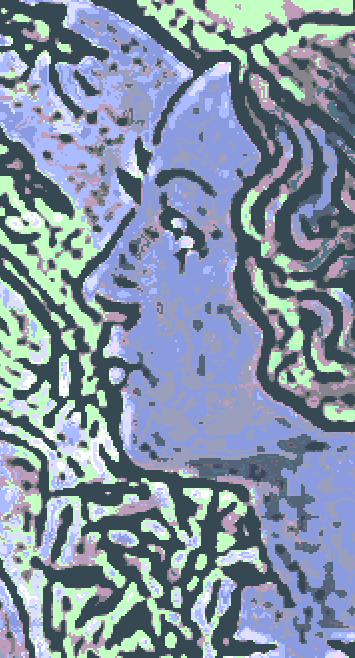
Watery female |
- Roman theology presents Venus as the yielding, watery female principle, essential to the generation and balance of life.
- Her male counterparts in the Roman pantheon, Vulcan and Mars, are active and fiery.
- Venus absorbs and tempers the male essence, uniting the opposites of male and female in mutual affection.

Planet Venus |
- The planet Venus is generally described as appearing yellowish-white or pearl white with a slight yellowish tinge when viewed from Earth.
- This is due to its thick atmosphere of carbon dioxide and sulfuric acid clouds, which are highly reflective and obscure the planet's surface.
- Second planet from the Sun.
- Scientists theorize that Venus fell victim to a runaway greenhouse effect; excess carbon dioxide trapping solar heat under the blanket of its atmosphere.
|
Because Venus’s orbit is nearer the Sun than Earth’s, the planet is always roughly in the same direction in the sky as the Sun and can be seen only in the hours near sunrise or sunset. When it is visible, it is the most brilliant planet in the sky. Venus is designated by the symbol ♀
(Britannica)
|
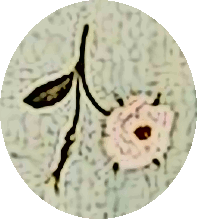
Simple as could be |
- This is mythological scene, more than
it's real life.
- Botticelli was never much into deep
perspective in his paintings the way Leonardo was, so as a
result, his landscapes were never very detailed.
- His
paintings had a beautifully simple almost cartoon feel to them
with crisp lines and bright colors.
- However, the roses
drifting down aren't random because in mystery cults, they
symbolized secrecy.
- Their petals hinting at truths only
revealed to those deemed worthy.
|
“Egg tempera” is just what it sounds like. It involved using egg yolk, pigment, and other ingredients like water and vinegar. Unlike oil paint, it dried very quickly. In order to paint shadows, you had to know what you were doing: Painting darker lines of various thickness layered on top. Sometimes artists would paint lines with a brush that only had one single bristle.
(baffledtimetravel.com)
|

Landscapes |
- The composition, with its flowing lines and harmonious balance, showcased Botticelli’s mastery of form and movement.
- Botticelli was quoted as saying he didn’t like painting landscapes, and that “by throwing a sponge soaked with different colors at a wall, one can make a spot in which a beautiful landscape can be seen.”
|
The above mentioned painter paints very bad
landscapes.
(Leonardo DaVinci)
|
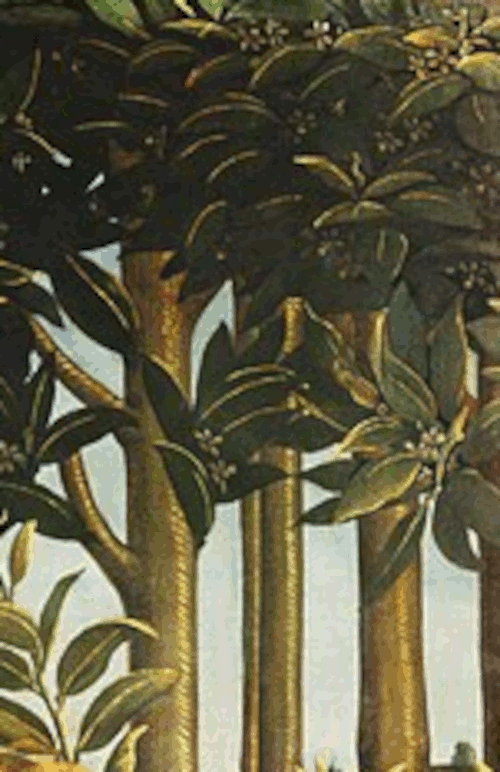
Bitter orange trees |
- The painting depicts the world of the imagination rather than being very concerned with realistic depiction.
- The
bitter orange trees at right
refers to the name Lorenzo who was Lorenzo de’ Medici, ruler of Florence, better known as
il Magnifico.
- Fruit can be seen among the orange
blossoms.
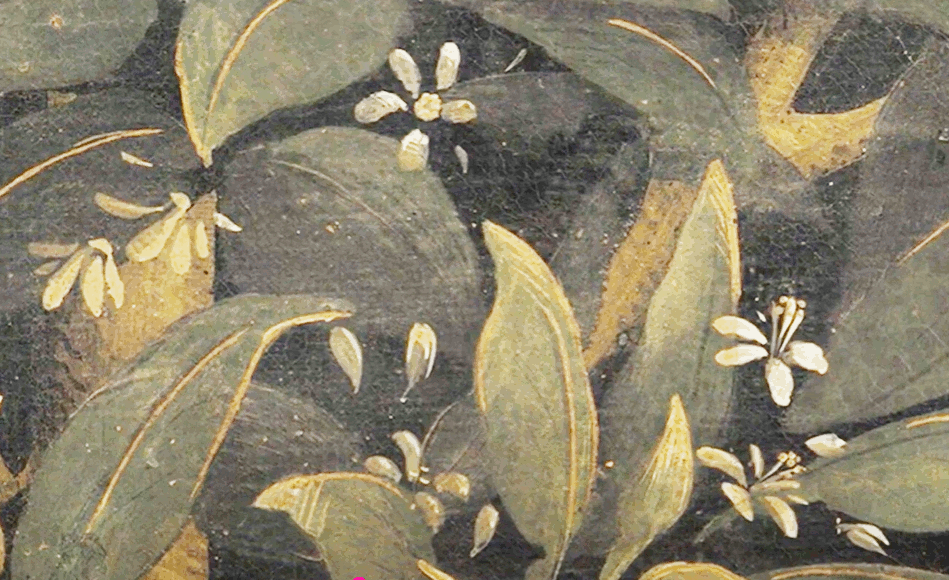
Orange blossom |
- The Citrus medica behind Flora was used for their
therapeutic properties alluding to the Medici and the orange
trees blooming with orange blossoms hint at weddings.
-
The precise purpose of the painting is unknown, but it was
more than likely created for the marriage of Lorenzo di
Pierfrancesco, age 19, in May 1482.
- He was a cousin and
was under the tutelege of the powerful Lorenzo the Magnificent Medici
who was one of Botticelli's greatest patrons.
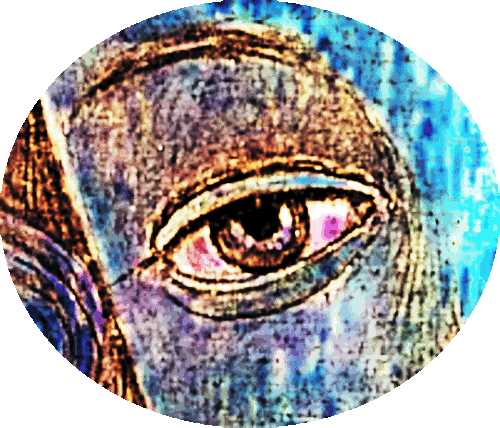
Iron maiden |
- His bride was Semiramide d'Appiani, 18, daughter of the Appiani lord Jacopo III of Piombino, who brought not only lucrative commercial ties but also political connections.
- Her dowry was 10,000 Florins but the primarly goal was
control of the iron on the island of Elba.
|
Citrus medica, the citron tree. While "mala medica" translates roughly to "Median apple" in ancient Greek, referring to its origin, it's more commonly known as the citron.
(Assistant)
|
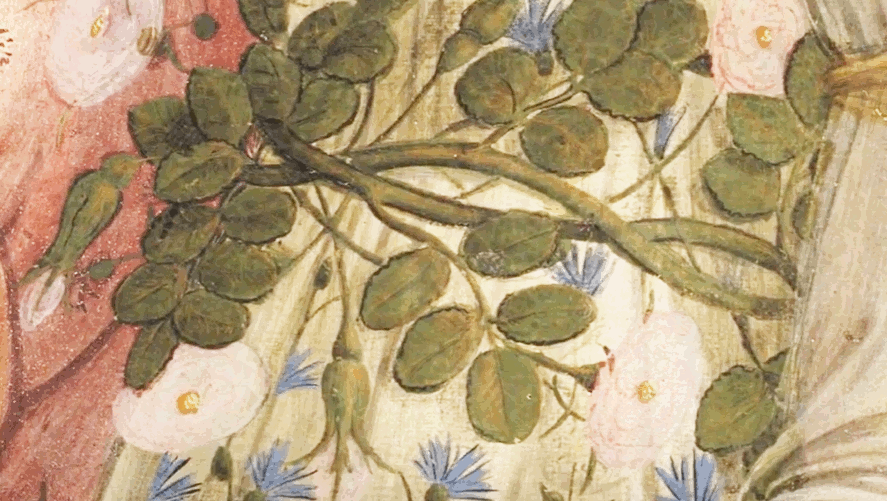
Rose leaves and buds |
- The myrtle, also called laurel, is another symbol
of Venus, and is worn in a wreath around the neck of her
attendant Hora and on her waist silks of roses.
- The
presence of laurel is also associated with Lorenzo de’ Medici
who made the trunk of the laurel, symbolizing eternal life and
victory, his personal emblem after hearing a passage from
Virgil.
- This is alternated with roses, a symbol of love, the
plants sacred to Venus.
|
While she was pregnant with him, [Virgil’s] mother dreamed that she gave birth to a laurel branch, which struck root when it touched the earth and sprang up on the spot, so that it looked like a full-grown tree, stuffed with diverse fruits and flowers. And the following day, while she was making for the neighboring fields with her husband, she turned aside from the path, threw herself into a ditch, and disburdened herself by delivering the child.
(Aelius Donatus, taken from Suetonius)
|
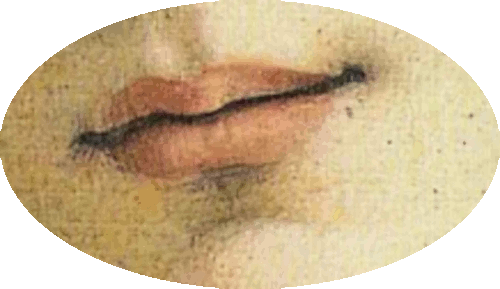
Virginal seed |
- Although the entire scene is filled with flowers, the
presence of fruit is just a promise of Zephyrus' winds.
- Additionally, there are no birds or
animals or even butterflies in the scene.
- This represents
the virginal seed that is planted and was represented in a
series of paintings by Botticelli including Primavera.
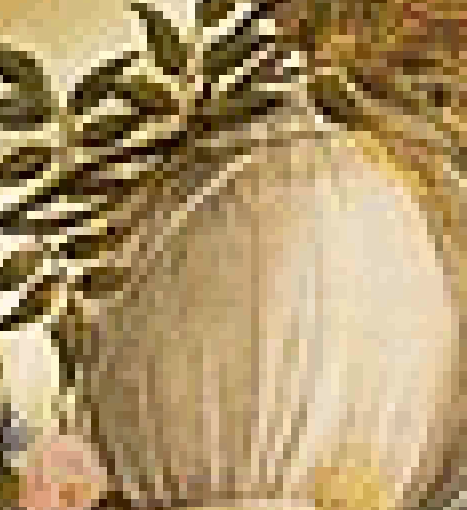
Divine fruit |
- The painting it is also showing a divine place where animal species
rank too low in the Ficinan supernatural hierarchy from the
theory that originally created life in the cosmos if only on a
symbolic level.
- Philosopher Marsilio Ficino revised the thought of Plato in a Renaissance perspective
and conceived the universe as a hierarchy of substances that descends from God to matter.
- Ficino believed that love is the foundation of the cosmos
since through it creation takes place.

Bitter orange |
- The varieties of citrus fruit attributable to the Medici era were the bitter orange, the citron from Florence, the limoncello from Naples and the Adam's apple.
- The Romans loved all citrus fruits, but especially oranges, the symbolic fruit of the
Medici family.
|
Botticelli’s Venus exhibits a dual, seemingly paradoxical nature: she is both shamed into modesty yet empowered by her sexual agency. Consequently, she may be understood as a symbol of sexual— and thus societal emancipation for oppressed and marginalized individuals.
(Sam Lirette)
|

Cyprus |
- The land more than likely represents either Cythera or
Cyprus, both Mediterranean islands regarded by the Greeks as
territories of Venus.
- Has been seen as a wedding painting that suggests
appropriate behaviors for brides and grooms.
- The painting
expresses a new hope, the rebirth of civilization,
geopolitical, social and cultural shift which occurred after
the turmoil of the Middle Ages.
|
The demand for this type of scene, of course, was humanism, which was alive and well in the court of Lorenzo d’Medici in the 1480s. Here, Renaissance humanism was open not only to the use of a pagan sculpture as a model, but also a pagan narrative for the subject matter.
(italianrenaissance.org)
|
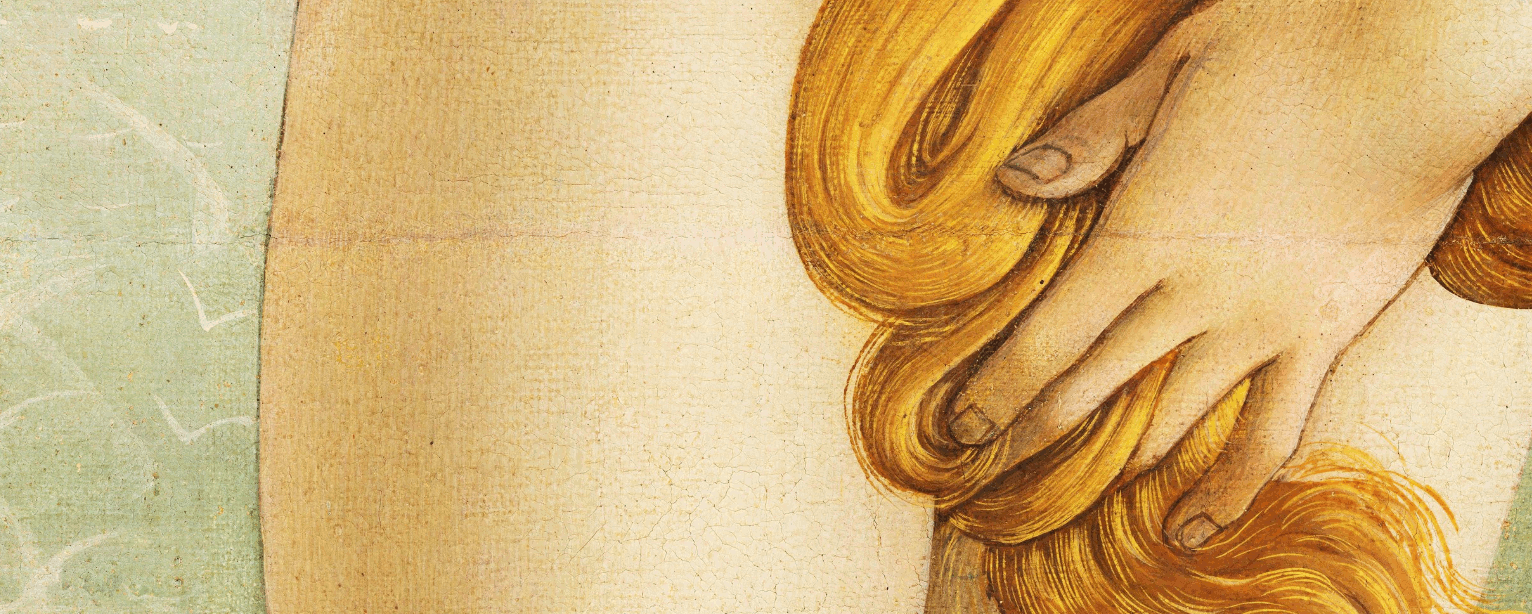
Delicate thumb |
- Venus thumb is obviously a thumb,
but some wonder if the painting is an early form of porn.
-
Which would lead them to question how 'pure' or 'chaste' she
was.
- This painting has a secret history that infers there
is something much more going on with her sexuality.
|
Venus' body is anatomically improbable, with elongated neck and torso. Her pose is impossible: although she stands in a classical contrapposto stance, her weight is shifted too far over the left leg for the pose to be held. The proportions and poses of the winds to the left do not quite make sense, and none of the figures cast shadows.
(Wikipedia)
|
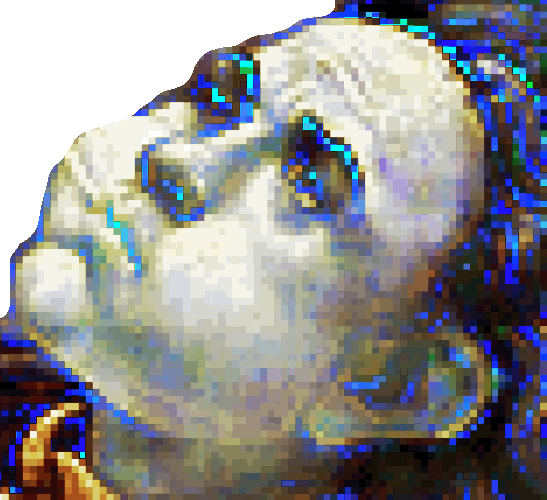
Tyrannical power |
- The original myth of Aphrodite further propels this
mystery as she was born from a violent act of emasculation.
- Aphrodite rose from the foam which formed from her father,
Uranus' genitals after the god Cronus (Saturn) had
'cut them off and thrown them into the sea.'
- She could
be interpreted as symbolizing the feminine good which comes from the overthrowing of masculine tyrannical power.
- In the Homeric Hymns, Aphrodite took on the active role of
sexual pursuits so she was definitely bending gender roles.
|
She transgresses mortal female nature by claiming active sexual desire, which is normally exclusively the prerogative of men. (Barbara Breitenberger)
|
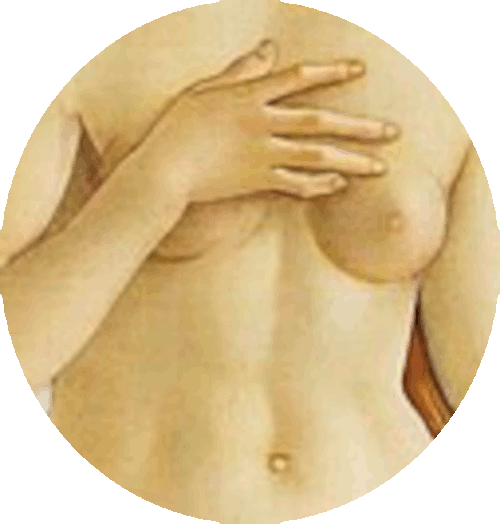
Gender role |
- It is also important to understand
how gender roles and sexuality were perceived in the
15th-century.
- Some three and a half centuries after Botticelli painted
Birth of Venus the categories of ‘male’ and ‘female’ were clearly defined as opposites.
- Which could further position ‘woman’ as the oppressed sex
as was the model promoted by the Old Testament.
- Gender roles are
much more strictly
defined today than in the 15th-century.
- Donatello’s David,
which was painted 45 years before Birth of Venus,
reveals how gender and sexuality were perceived.
|
Historian and sexologist Thomas Laqueur argues that a radical change in attitudes concerning human sexual anatomy occurred in eighteenth- and nineteenth-century Europe.
Evidently, such dichotomous ideas on sex and gender were created at the time that artworks such as Botticelli’s were rediscovered and became part of the canon. (Sam
Lirette)
|
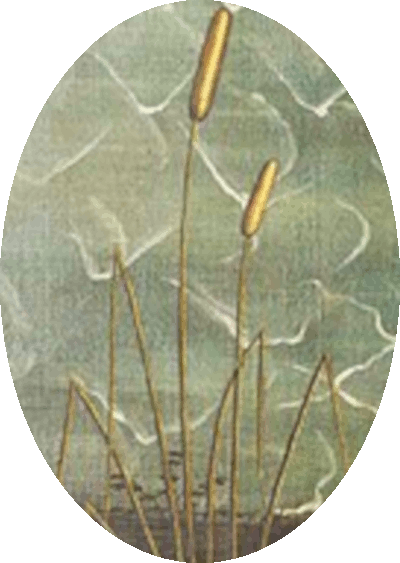
Bulrushes |
- The clumps of bulrushes in the left foreground are out of place here, as they come from a freshwater species.
- This plant is also called Typha (cattail) and some of their stems are broken.
- Leonardo DaVinci's Baptism of Christ also has a
bulrush depicted in the bottom left corner of the painting.
- Botticelli's Venus has often been compared to DaVinci's
Christ because of the partial nudity of the central figure and
two individuals stationed on the left and one on the right.

Typha branches bent |
-
The imagery of bulrushes in the Bible often conveys themes of survival, adaptability, and the sustaining power of God amidst challenging circumstances.
- We see Tyhpa gently swaying in Zephyrus' breeze and it is a
marsh weed and is clearly a phallic symbol.
- It implies
the coming fertilization to generate fruit to fill the earth
with life.
- Interestingly, some stems appear bent or
broken indicating that not everyone will have the synergy with
the goddess of love and fertility.
|
Common names: Reeds, pencil reeds. Location: Marshes, shorelines, sand and gravel bars, shallow waters up to 8 feet deep. Hardstem bulrush grows on firm bottoms; softstem bulrush grows on mud bottoms. (Assistant)
|
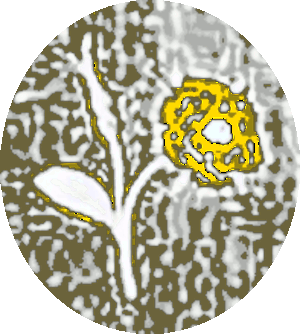
Mari-gold |
- The painting was not universally admired when it was first unveiled.
- In fact, it sparked controversy and debate, challenging societal norms and provoking both admiration and criticism.
- Art during this time often had religious themes and Biblical stories, saints, and Christian virtues were the subjects of choice for many artists.
|
And so soon as he had cut off the members with flint and cast them from the land into the surging sea, they were swept away over the main a long time: and a white foam spread around them from the immortal flesh, and in it there grew a maiden.
(Hesiod, Theogony)
|
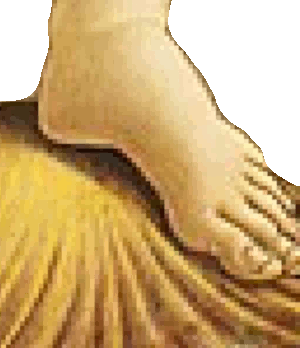
Fine line |
- While classical themes were being rediscovered, their
incorporation into art had to tread a fine line.
- Venus was a pagan goddess, representing love, beauty, and sensuality, concepts that could be seen as contrary to Christian teachings about chastity and modesty.
|
Ancient mythology, with its pantheon of gods and goddesses, presented a stark contrast to Christian monotheism, and its celebration of human sensuality and beauty could easily be seen as subversive.
(gerrymartinez.com)
|
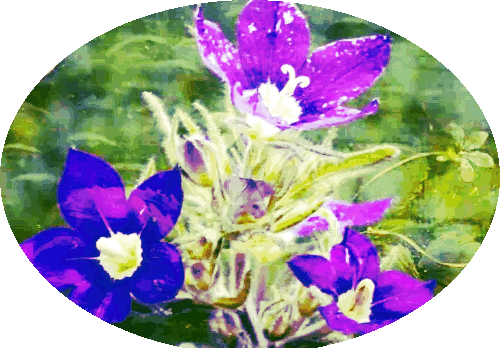
Speculum Veneris |
- At Venus' feet lies a Speculum Veneris, Venus looking
glass, a flower that refers to the beauty of the goddess.
|
The artist has the ability to show through a physical image a spiritual truth.
(Ars Europa Channel)
|
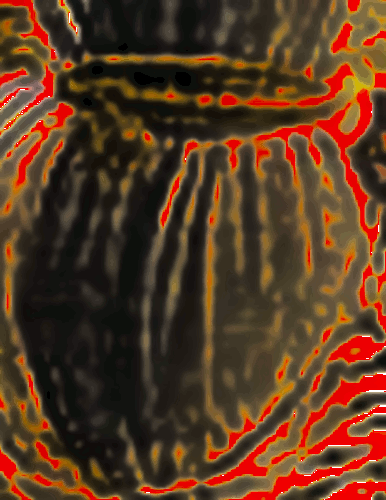
On fire
|
- The controversy surrounding the painting became even more pronounced with the rise of Girolamo Savonarola, a Dominican friar who preached against the moral decay of Florence.
- Savonarola condemned the Medici and their patronage of art that he saw as vain, secular, or indulgent.
|
While there is no direct evidence that The Birth of Venus was targeted in these purges, Botticelli himself is said to have been influenced by Savonarola’s fervor. Some accounts suggest that Botticelli even destroyed some of his own works in response to the friar’s teachings. The climate of fear and censorship created by Savonarola’s movement undoubtedly contributed to the painting’s controversial status.
(gerrymartinez.com)
|
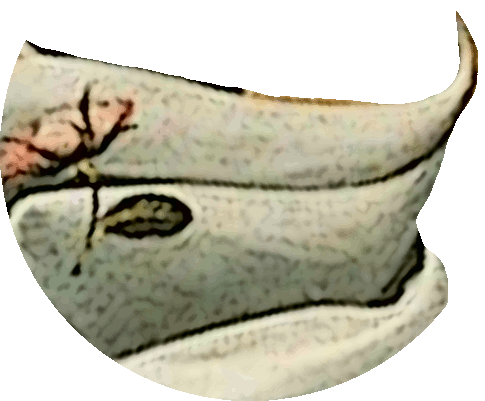
Zealot in his image |
- Savonarola called for a return to strict Christian values and led the infamous
Bonfire of the Vanities on Shrove Tuesday in 1497, where 'immoral' books, artworks, and luxury items were burned.
|
He even had gangs of creepy kids who’d run from house
to house, confiscating things like mirrors and
paintings and musical instruments. Can you imagine?
Brainwashed hordes of children, ransacking your
bedroom in bowl cuts, probably chanting something in
Latin. No, I don’t know if they had bowl cuts. But
they might have. And it’s creepier that way.
(gerrymartinez.com)
|
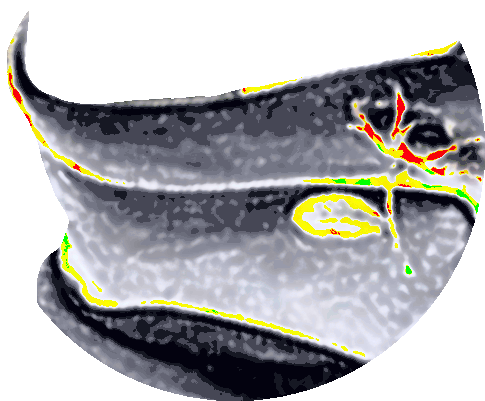
Scorched twin |
-
Savonarola was the prototype of the wild-eyed, hellfire and brimstone religious extremist.
- He took control of Florence, expelling the famed Medici family, preaching of the dangers of pleasure.
|
He shall spurn fate, scorn death, and bear His hopes 'bove wisdom, grace and fear: And you all know, security Is mortals' chiefest enemy.
(Shakespeare)
|

Tamed |
- After Botticelli painted his Birth of Venus a religious turn in Florence began to condemn pagan and sexual imagery.
- As a result, Boticelli’s later works moved away from his depictions of Greek mythology towards religious imagery
and Venus was transformed from an erotic image of sex and desire to the sacred image of the Madonna.
|
Like wasting fire her senses wild among. (Percy Bysshe Shelley, Homer's Hymn to Venus)
|
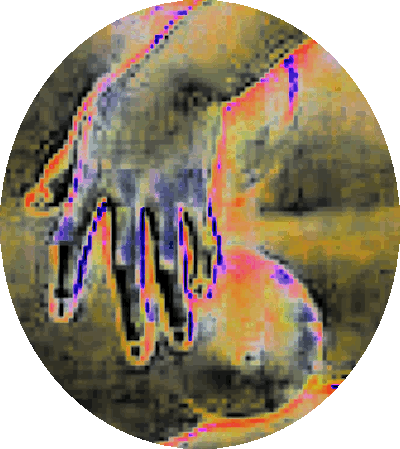
World influence |
-
The popularity of the painting continues to influence modern art and culture.
- Its imagery is widely recognized and has been referenced in various forms of media, including films, literature, and advertising.
- It's more than just a painting; it's a symbol of the Renaissance itself, a blend of artistic genius, classical inspiration, and rich symbolism.
- It embodies the spirit of an era that celebrated humanism, beauty, and the power of art to capture the divine.
|
It is a remarkable reconciliation of pagan traditions with Christian one, a unification of pre-Christian religion with Christian enlightenment. That, in itself, is at the core of the Renaissance enterprise. (Ellen B Cutler)
|
|
|

